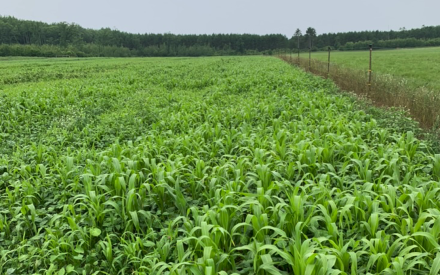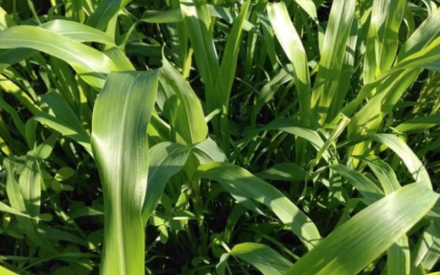The decision to utilize late-summer planted forage crops as a feed source may be necessary when in-season crop yields fail to meet expectations or opportunities exist in the current crop rotation. One should evaluate the decision to plant and harvest late-summer planted forage crops carefully. The following steps can help determine your need and ability to plant late-summer planted forage crops.
- Conduct a forage inventory (https://livestock.extension.wisc.edu/files/2020/09/forage-inventory-and-needs.xlsx) to determine your forage needs including a reasonable estimate of known feeds yet to be harvested (e.g. corn silage, corn stalks, etc.).
- Contact your crop insurance agent to determine if a late-summer planted forage crop affects your coverage.
- Determine any potential restrictions as a result of herbicide or other crop protection products previously applied.
- Consult your nutritionist to determine how the forage will be used in the ration.
- Determine that a late-summer planted crop provides a return on investment (https://cropsandsoils.extension.wisc.edu/article-topic/economics-budgets-financial/).
These are the major considerations for a late-summer planted forage crop:
1. Species Selection
Determine if you have fall or spring forage needs. Consider selecting a forage that will provide the level of quality desired for the animals being grown.
- Fall forage needs can be met by a late-summer seeded oats. Fall seeded oats are higher in quality than spring seeded oats: (https://fyi.extension.wisc.edu/forage/fall-grown-oat-forages-cultivars-planting-dates-and-expected-yields/)
- Warm season annuals (sorghum-sudangrass) or forage cocktail mix for mid-October harvest. (https://fyi.extension.wisc.edu/forage/sorghums-sudangrass-and-sorghum-sudan-hybrids/)
- Spring forage needs can be met by planting cereal rye or winter triticale for harvest. (https://fyi.extension.wisc.edu/forage/files/2017/06/Rye_090507_final-1.pdf)(https://fyi.extension.wisc.edu/forage/fall-forage-rye-for-dairy-heifers-and-dry-cows/)
2. Planting Date(s) and Potential Dry Matter (DM) Yields
- Late-summer seeded Oats/Oats and Peas should be planted in the northern half by Aug. 10-15th or September 1st in the southern part of Wisconsin.
- Annual Warm Season Grasses (Sorghum-sudangrass) or Cocktail Mixes should be planted by August 10th Northern, August 15th Southern.
- Cereal Rye and Winter Triticale should be planted for forage purposes ideally in mid-September – Oct. 1st. Plantings can occur later, understanding yield potential will be lower.
- Yields of late summer planted forage crops will vary based on species, planting date, soil fertility, precipitation, growing degree days (GDD’s) accumulated, and the stage of maturity.
| Table 1. Late-Summer and Spring Planted Forage Options for Wisconsin | |||
|---|---|---|---|
| Crop | Planting Time | Harvesting Time | Yield Potential |
| Fall oats | Mid-August | Late-October | 1-2 tons/acre |
| Fall oats and peas | Mid-August | Late-October | 1-2 tons/acre |
| Sorghum-sudangrass | Early-August | Mid-October | 2-4 tons/acre |
| Winter cereal grain | Mid-Sept. | Mid-May | 3-3.5 tons/acre |
| Spring oats | Mid-April | Late-June | 2.5-3 tons/acre |
| Spring oats and peas | Mid-April | Late-June | 2.5-3 tons/acre |
| Fall oats + Winter cereal grain | Mid-August | Late-Oct. & Mid-May | 3-5 tons/acre |
| Forage brassicas | Early-August | Early-October | 2-3 tons/acre |
| Italian Ryegrass | Mid-April/May | Late June | 2.5-5.2 tons/acre |
| Italian Ryegrass-Legume Mix | Mid-April/May | Late June | 2.5-7.5 tons/acre |
| Source: Steve Barnhart, retired ISU Extension forage specialist | |||
Additional information at: https://fyi.extension.wisc.edu/forage/alternative-forage-crops/
3. Soil Test Levels and Plant Nutrient Needs
Spring Forages
Fertilization requirements, nutrient uptake, and removal with harvest vary by forage species and soil-test levels. Results from three Wisconsin studies for winter rye, rye and triticale, Italian ryegrass, and Italian rye-legume mixtures are shown in Table 2. Studies showed optimum N fertilization rates of 40 to 85 lb N/a (per cutting) depending on the forage (Table 2). Removal rates did not vary widely between studies with 17 to 18 lb P2O5/a, 81 to 84 lb K2O/a, and 4 to 5 lb S/a removed per ton of dry matter across all forages.
Summer forages
Fertilization guidelines and estimated nutrient removal with harvest for selected summer forages are shown in Table 3. Values shown in Table 3 are for soils with 2.0 to 9.9% soil organic matter and optimum soil-test P and K. Fertilization requirements are based on soil-test level and estimated removal. Fertilization planning for 2024 crops should consider removal of summer-planted forages in addition to guidelines provided by UWA2809. Soil sampling after forage harvest and planting subsequent crops is advised.
Table 2 shows dry matter yield, nutrient uptake (pounds per acre), and nutrient removal (pounds per ton of dry matter) for Wisconsin alternative forage studies.

Table 3 shows dry matter yield, nutrient uptake (pounds per acre), and nutrient removal (pounds per ton of dry matter) for Wisconsin alternative forage studies.

4. 90-Day Precipitation and Temperature Outlook
NOAA (National Oceanic Atmospheric Administration) 90-day outlook maps: https://www.cpc.ncep.noaa.gov/products/predictions/90day/.
5. Weather Conditions at Harvest Time- Plan accordingly
- Fall Harvest – Short days and heavy morning dew may limit your ability to wilt forage to 60% moisture. Have a plan to segregate from other forages if needed.
- Spring Harvest –Spring weather conditions will influence your harvest timing. Monitor weather forecasts and patterns for planting of the next crop.




 Summer Annual Forages: Diversify your feed
Summer Annual Forages: Diversify your feed ▶ Watch: Focus on Forage Cover Crops
▶ Watch: Focus on Forage Cover Crops Prussic acid and nitrate toxicity in sorghums
Prussic acid and nitrate toxicity in sorghums Focus on alternative forages
Focus on alternative forages


